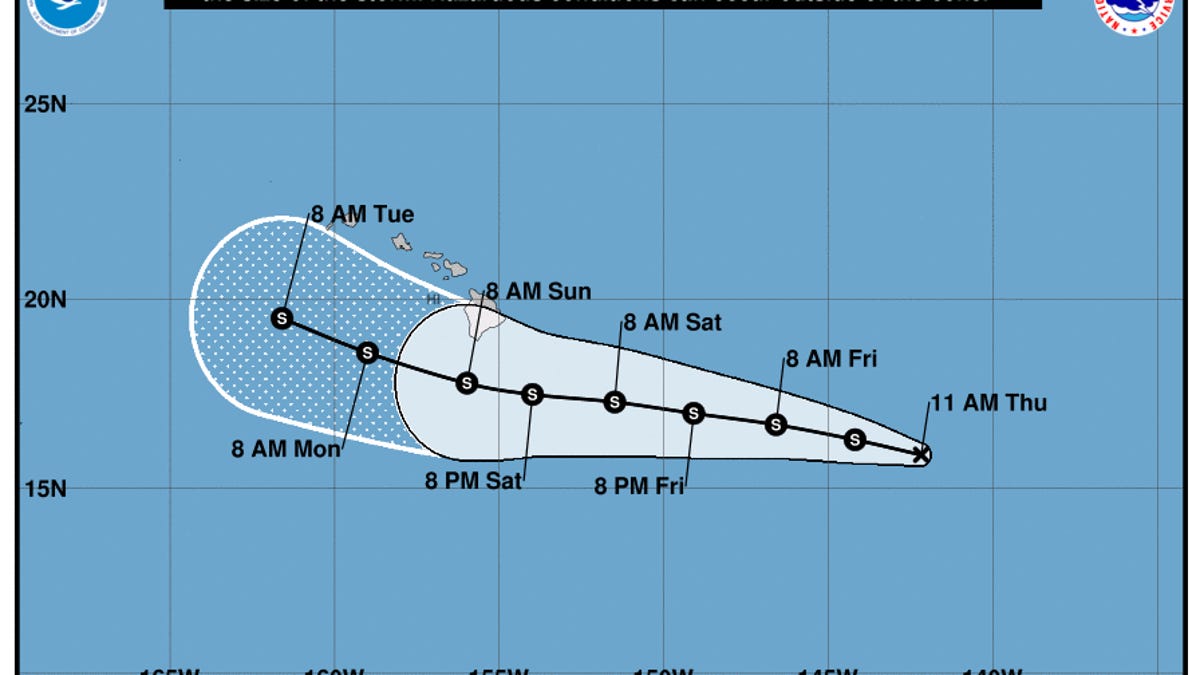Tropical Storm Hone expected to strengthen as it approaches Hawaii this weekend
On Friday, tropical storm watches were issued for the Big Island of Hawaii as authorities kept a close watch on Tropical Storm Hone, which is projected to bring hazardous surf conditions and potential flooding as it strengthens over the weekend.
Tropical Storm Hone is one of three systems currently active in the Pacific, alongside Hurricane Gilma, a Category 3 storm, and another developing system in the east, all moving towards the Hawaiian Islands.
Hone became the first named storm of the 2024 central Pacific hurricane season on Thursday after a series of storms combined and organized in the open sea. As of Friday morning, the storm was situated 620 miles east-southeast of Hilo and 830 miles east-southeast of Honolulu, as reported by the Central Pacific Hurricane Center.
The storm is traveling at a speed of 16 mph, with maximum sustained winds reaching 45 mph that extend 90 miles from its center. Tropical Storm Hone is expected to gain strength over the next few days and is forecasted to pass south of Hawaii’s Big Island Saturday night into Sunday.
As Hone moves past Hawaii, the warmer ocean temperatures and low wind shear “could allow Hone to reach hurricane strength,” according to meteorologists.
Hone expected to create life-threatening rip currents and possible flooding
In addition to strong winds, the storm is predicted to bring 4 to 8 inches of rain to parts of the Big Island, with even higher totals possible in certain areas, according to the hurricane center.
“There is a risk of excessive rainfall and flash flooding on parts of the Big Island beginning late Saturday, continuing through Sunday and potentially into Monday,” said the hurricane center.
Moreover, swells generated by Hone are “likely to create life-threatening surf conditions and rip currents” starting this weekend.
Significant rain could alleviate drought and reduce wildfire risk in Hawaii
A moderate amount of rainfall from Hone would be beneficial for Hawaii, which is currently facing drought conditions.
After a very dry week, “abnormal dryness has spread to the north shore of the Big Island, leading to all of the Big Island and the entire state facing from abnormal dryness to extreme drought,” reported the U.S. Drought Monitor in its latest update.
Due to the severe drought, the islands desperately need moisture from Hone, AccuWeather experts note, to mitigate the wildfire threat. However, tropical storms can be unpredictable and may bring strong winds without the accompanying rain:
“If Hone loses its organization and some rain bands diminish, the leeward sides of the mountains may receive little or no rainfall and instead experience strong winds, which could elevate wildfire hazards,” stated AccuWeather hurricane analyst Alex DaSilva.
– Doyle Rice, YSL News
Hawaii observes Hurricane Gilma’s progress in the eastern Pacific
To the east, meteorologists are following the development of Hurricane Gilma, a Category 3 storm traveling over the open Pacific that may pose a risk to Hawaii by the end of the month.
Meteorologists expect Gilma to continue its westward path as a major hurricane before beginning to weaken as it encounters cooler waters and increased vertical wind shear. Gilma could lose its hurricane status as early as next week.
Nevertheless, AccuWeather cautions that even in a weakened state, Gilma could still produce heavy rainfall, strong winds, and rough seas across the Hawaiian Islands.
As per Friday’s information, the storm’s sustained winds reached up to 115 mph, and it was located 1,160 miles west-southwest of the southern tip of Mexico’s Baja California and 1,855 miles east of Hilo, Hawaii, according to the National Hurricane Center.
System shows an 80% chance of developing into a named storm
A storm system in the eastern Pacific is anticipated to strengthen as it travels west towards the Hawaiian Islands; however, it is still uncertain how closely it will approach the state.
According to the National Hurricane Center, the storm has an 80% likelihood of evolving into a named storm within the next 48 hours.
As of Friday morning, this storm system was situated a few hundred miles south-southwest of the southern tip of Baja California, Mexico. If the storm continues on its current trajectory, it could take over a week before it reaches near Hawaii.

